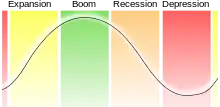Lundberg lag
The Lundberg lag, named after the Swedish economist Erik Lundberg, stresses the lag between changes in the demand and response in output. This is one lag which points out that business cycles do not follow a completely random fashion but can be explained with a few different important regularities.[1][2]
 | |
|---|---|
| Cycle/wave name | Period (years) |
| Kitchin cycle (inventory, e.g. pork cycle) | 3–5 |
| Juglar cycle (fixed investment) | 7–11 |
| Kuznets swing (infrastructural investment) | 15–25 |
| Kondratiev wave (technological basis) | 45–60 |
See also
Notes and references
- Burda, Wyplosz (2005): Macroeconomics: A European Text, Fourth Edition, Oxford University Press
- Van Doorn, J. (1975), "Micro-Disequilibrium Economics", Disequilibrium Economics, Macmillan Education UK, pp. 28–44, doi:10.1007/978-1-349-02131-4_2, ISBN 9780333155912
This article is issued from Wikipedia. The text is licensed under Creative Commons - Attribution - Sharealike. Additional terms may apply for the media files.